You Know My Steez draws down the curtain on the first season of Luke Cage.
In many ways, the season finale encapsulates the best and worst of the season before it. The episode is strongest when it focuses on the characters and their performers, allowing space for actors like Alfre Woodard and Simone Missick to breath. It underscores the core themes of the season, from the importance of having a black superhero show through to the cultural significance of Harlem. Indeed, You Know My Steez does an excellent job bringing the show around a full circle from Moment of Truth and Code of the Streets.

At the same time, there is an awkwardness and a clumsiness to the storytelling, from the decision to open with an underwhelming fifteen-minute brawl in the centre of Harlem to the choice to spend the rest of the episode setting up threads to be divided between an inevitable second season and the launch of The Defenders. Pacing and structure have never been a strength for Luke Cage, and that is particularly obvious with You Know My Steez. It is an episode that seems stitched together from a selection of dangling threads leading into and flowing out of the season.
Still, You Know My Steez has a winning charm to it, one that almost excuses the strange pacing and the contrived plotting. If anything, the decision to wrap up the inevitable climactic throw down a full half-hour before the end of the episode ensures that Luke Cage never loses sight of its characters and its world.

To be fair, the Netflix Marvel shows generally don’t have particularly strong conclusions. Both seasons of Daredevil suffered somewhat from the demands of a big action climax. Daredevil had the police arrest Wilson Fisk, only to have him escape so that Matt Murdock could deliver the superhero-story-mandated beatdown. A Cold Day in Hell’s Kitchen inexplicably featured a bunch of ninjas siezing control of a building in Hell’s Kitchen without a clean endgame or plan, beyond the fact that the season was coming to an end and a big set piece was needed.
Luke Cage suffers from this problem in some respect, building to an inevitable brawl between Luke Cage and Willis Stryker that has been brewing since Blowin’ Up the Spot just after the midpoint in the season. In the series’ defense, this fight sequence makes a lot more sense than either of the big fight sequences closing the two seasons of Daredevil. More than that, the scale is kept reasonably small and the episode is structured so that the brawl is neatly wrapped up about one third of the way through the episode.
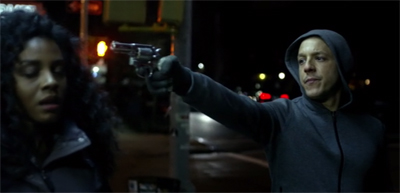
Still, the fight feels obligatory. There is no reason why Luke and Willis have to fight now. In fact, it would have made for sense for the characters to force a confrontation at the end of Now You’re Mine, the last time that they were in close proximity to one another. Instead, like their introductory brawl in Blowin’ Up the Spot, that confrontation conveniently ended with one of the two characters slipping away at the moment of defeat so they could fight again at a later date. It seems like the only reason the brawl in You Know My Steez is conclusive is because it is the finale.
There are other structural issues with these superhero finales, most notably a tendency to position the climax towards the middle of the second half of the season in a way that renders the finale an afterthought. This was a problem with Jessica Jones, a show that hit its climax with the triptych of AKA WWJD?, AKA Sin Bin and AKA 1,000 Cuts before losing a little steam as it ran into the final couple of episodes. To a certain extent, that happened here, with the big action climax coming in Now You’re Mine. As such, You Know My Steez feels superfluous.

There is also the fact that the Netflix superhero show tend to build towards familiar and bombastic finales, that are not always easy to replicate on a television budget with a television product schedule. Superhero blockbusters come with a built-in sense of scale. The attack on New York at the climax of The Avengers stands out as one of the most impressive set pieces within the history of the genre, although that level of urban destruction is matched in films as diverse as Man of Steel and Guardians of the Galaxy.
Neither Daredevil nor Luke Cage build to an existential threat to the entire island of Manhattan, but they do both feature impressive spectacle. A Cold Day in Hell’s Kitchen features an undead cult of ninjas standing against the New York City Police Department, while You Know My Steez opens with two super-powered individuals knocking each other up and down Harlem. There is a conscious desire to emulate the scale and style of these superhero climaxes. “This is nothing less than a battle for the soul of Harlem,” Mariah states, simply.

In fact, the super-powered brawl in You Know My Steez seems to consciously evoke the climax of The Incredible Hulk, the oft-maligned second film in the Marvel Cinematic Universe that featured Ed Norton’s first and only appearance as the giant green goliath that built towards a brutal confrontation between the Hulk and the Abomination in the heart of Harlem. It was the first time that Harlem appeared in the Marvel Cinematic Universe, although the sequence was filmed in (a somewhat questionably disguised) Toronto.
Despite the fact that the film’s post-credits sequence featured a cameo from Robert Downey Junior and William Hurt’s appearance in Captain America: Civil War, that particular film has largely been ignored in terms of Marvel’s shared continuity. In fact, it is telling that the kid with bootlegs in Moment of Truth was selling footage of “the Incident” from The Avengers, but not footage from the wrestling match between the Hulk and the Abomination at the end of The Incredible Hulk.
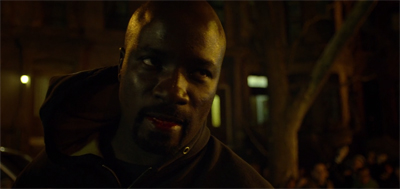
In some respects, the battle in You Know My Steez feels like a conscious attempt to restage and rework that climactic superhero battle in the context of Luke Cage. While those bootleg filmmakers might have missed that particular monster mass, they opt to capture this moment for posterity. “Bring the camera!” one urges. “The 4K one. Luke Cage is goin’ at it.” This is presented as very much a big deal for everybody involved. Claire Temple is even watching the fight on the evening news, this “Super Rumble” broadcast live.
As such, there is a sense that this is meant to be the climax of the season’s big super story. This is very much Luke Cage hitting a beat expected of a stock superhero story in the most enthusiastic manner possible. Like the origin story in Step in the Arena or the hero montage of Just to Get a Rep or the cheesy supervillainy of Blowin’ Up the Spot, the super-powered grudge match of You Know My Steez is an eager embrace of a stock superhero trope without a hint of irony or cynicism.
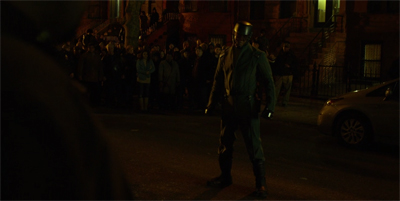
In fact, the brawl in You Know My Steez takes pains to carefully root itself in the context of Harlem. Luke and Stryker battle it out on Malcolm X Boulevard, a street that has a great deal of cultural weight, the central thoroughfare through Harlem. As Sharifa Rodes-Pitts writes of the geography:
Lenox Avenue begins there at 110th Street and ends up at 149th Street or so; I have never been to the very end of it. At the end a bridge goes over the Harlem River and then suddenly it is the Bronx. The Harlem River is not a real river, just as the Harlem Meer is not a sea or even a real lake, and Lenox Avenue is technically Sixth Avenue. Downtown it is called Avenue of the Americas before it runs into the south end of the park, and up town it is called Malcolm X Boulevard, but only by the kind of person who insists on calling Bombay Mumbai or Calcutta Kolkata. They would also feel the need to call Eighth Avenue, Frederick Douglass Boulevard and Seventh Avenue, Adam Clayton Powell, Jr., Boulevard. One Hundred Twenty-Fifth Street is also called Martin Luther King, Jr. Boulevard, but I’ve never heard anyone insist upon it. I don’t call any of these by their second names. The point is that Lenox Avenue doesn’t go anywhere, and yet it is thought to be the most important thoroughfare of the most important place for black people in America, if not the world.
Lenox Avenue was home to such important fixtures of African American life as the Cotton Club or the Lenox Lounge. That is how firmly Luke Cage is rooted in Harlem, to the point that the barbershop itself can be placed at Lenox Avenue and West 119th Street and even the Mount Olivet Baptist Church is a recurring background element.
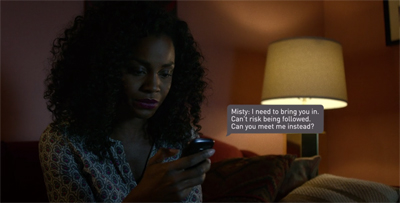
This makes for a sharp contrast with the climax of The Incredible Hulk, a sequence nominally set in Harlem but filmed in Canada. In many ways, this all ties back into one of the core themes of Luke Cage, the idea of authenticity. The Incredible Hulk was a film that treated Harlem as a generic location for a superhero smackdown, one written by white writers, directed by a white director and starring mostly white actors. However, You Know My Steez makes a point to treat Harlem as more than just a backdrop for massive urban carnage.
Unfortunately, there are limitations imposed on You Know My Steez. As great as it is to anchor that brawl in a sense of place, the reality is that Luke Cage simply cannot match the spectacle or scale of a conventional superhero climax. As such, the brawl between Luke and Stryker looks more than a little ridiculous and campy as two stunt men knock one another through the air for the amusement of a small assembled crowd. Operating on a Netflix budget, You Know My Steez ultimately seems too small for a superhero smackdown.

The brawl rages long enough for Claire to make it to the scene, and is featured on as a headline news story, but it never seems to attract more than two dozen observers and a handful of police officers. There is a single news helicopter overhead capturing footage, but there does not appear to be any police helicopters intervening. There are no snipers in position, just a tactical team within about twenty feet of the brawlers. Even the somewhat sparse police cordon in A Cold Day in Hell’s Kitchen seemed more convincing.
It is tempting to label this as a budgetary issue and move along, accepting that there are certain production realities that dictate what can and cannot be accomplished within the confines of Luke Cage. The fight might have looked more convincing on a smaller and narrower street, or in a confined space. After all, the same number of extras made Harlem’s Paradise seem bustling in Now You’re Mine. However, for the production team, setting the brawl on the wide open Lenox Boulevard was more important than make the space feel crowded or packed.

That said, there is also a sense that the sequence is simply not directed and edited for maximum impact. After all, it is possible to disguise issues with budget and crowd size through judicious editing and framing choices, but the fight sequence in You Know My Steez is filmed in a very straightforward manner. Indeed, this is a larger issue with direction and style within the Marvel Cinematic Universe, where there is much stronger emphasis on conveying a sense of physical location and force than in conveying a sense of tone or style.
Even the flashbacks to Luke’s teenage years feel clumsily intercut with the brawl. These sequences very clearly exist to establish a sense of context and motivation, to generate a sense of tragedy to the battle between Luke and Stryker. These sequences are a good idea on paper, even if it might have made more sense to include earlier in the year. Stryker is a very two-dimensional antagonist, and the flashbacks in You Know My Steez feel like too little too late when it comes to developing his relationship with Luke. They are also integrated rather clumsily.

In fact, it is worth looking back at the work that Vincenzo Natali did in Step in the Arena, particularly during that epic brutal fight montage. That sequence is one of the most visceral and effective sequences across the entirety of the first season, having an energy that is sorely lacking from the brawl in You Know My Steez. Similarly, Guillermo Navarro’s work on Who’s Gonna Take the Weight? had a much more kinetic quality to it. The fight sequence in You Know My Steeze falls a little flat, by comparison.
To be fair, it feels like Luke Cage is aware of these limitations and the absurdity of the brawl. More interesting than that grudge match between Luke and Stryker is what unfolds around it. As with Luke’s jog at the start of Suckas Need Bodyguards and Method Man’s reflections over the montage in Soliloquy of Chaos, the episode finds room for running commentary. “Who is this man?” Mariah asks. “Did he sweep Pop’s Barber Shop, or is he former-cop-turned-criminal, Carl Lucas, who I heard escaped from Seagate Prison? I don’t know. I mean, look at these super freaks.”

There is an endearing emphasis on the people around Luke, with the 4K camera capturing the action and Aisha Axton coming out in support of the hero. There is something delightfully goofy in the way that the bystanders invest themselves in the fight after Stryker offers some smack talk about Luke’s mother. “Wait, wait, wait,” one observer within earshot of an earth-shattering super-brawl interjects. “Yo, the dude’s talking about your moms, Luke? You reppin’ Harlem, you better put it on him, son.”
In fact, the most charming aspect of the entire match occurs long after the dust has settled. After Luke has defeated (and seemingly paralysed) Stryker, he enjoys a small moment with Claire. As they talk, an elderly Harlem resident walks casually through the frame. “Luke Cage, thanks for keeping Harlem safe, baby,” the resident offers, without stopping. Luke simply smiles and offers a casual “v-for-victory” gesture towards the old man, who is already out of the frame. It is a small moment, but one that captures the character’s arc as perfectly as his big speech.

There is something slightly frustrating in the way that the big climactic battle wraps up with with half-an-hour of plotting left to go. This half-hour is somewhat evenly divided between wrapping up dangling plot threads from earlier episodes and setting up what is to come; whether in the second season of Luke Cage or the launch of The Defenders. This is not bad by any measure, adding a sense of symmetry to the season and giving Alfre Woodard a lot of great material to play. However, it also feels a little inelegant.
Woodard is very much Luke Cage‘s secret weapon. Mariah Dillard’s arc across the first season occasionally feels a little decompressed and uneven, most notably in the second half when she is treated as a secondary antagonist to Stryker. As with a lot of the season around it, the pacing of Mariah’s arc feels a little off. It seems like the whole season is spent waiting for Mariah’s villainy to really begin, as if manoeuvring her into position for an arc on the second season of the show. Given the second season is several years out, this is frustrating.
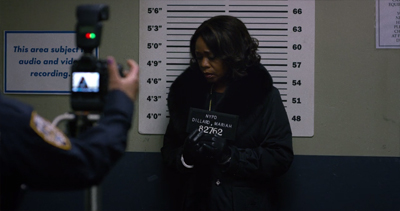
However, Woodard makes the arc work. Woodard is one of the stronger performers in a strong ensemble, and she does fantastic work. Indeed, her performance in You Know My Steez is very much a microcosm of Woodard’s excellent work on the series, bouncing from the moral outrage of her press commentary to her staged emotional breakdown in the police station to her contempt for Misty to her downright playful dismissal of Luke before finally assuming her place at the head of Cornell’s empire.
In fact, much like the best moment of the street brawl is a simple character interaction after the dust has settled, Mariah’s best moments are small interactions after she has evaded justice. When Luke demands the folder that can prove his innocence, Mariah seems to relish being put back in a position of power. Flicking her gloves at a man twice her size, she taunts “buh-bye!” before skipping away down the corridor. It is a gloriously petty moment, but one that feels entirely earned, a sign of how vindictive Mariah has become that she takes such pleasure where she can find it.

This teasing of Mariah’s descent into villainy fits quite comfortably with a lot of the rest of the finale, with the production team aligning the show for a second season and putting Luke Cage into the position from which he might join The Defenders. In interviews, producer Cheo Hodari Coker has argued that the production team are not treating the second season as an inevitability, although they do have some ideas:
Well, I mean Finn Jones will be in the mix for The Defenders. In terms of Luke Cage, Netflix has to order a second season first. And trust me, I don’t take any of this for granted because I mean there was no more sure thing than Vinyl.
We’re not treating it as a one-off, and I’m confident people will dig the show, but, trust me, like season two, I’ve got a few ideas. But we really won’t get ready until Netflix sees the viewership, and hopefully the subscriptions that will come from this show, and then they’ll say, ‘Let’s get into it.’
In fact, Coker has gone on record with some of the themes that he might like to incorporate into that hypothetical season, “If we get a season two, it’s going to explore more of how a hero evolves, when most heroes have a mask or are able to hide certain aspects of themselves, but Luke is out there.” It is an interesting idea, and one that build organically on the themes of the first year.
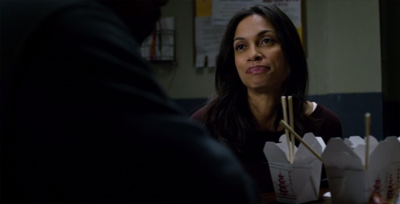
At the same time, some of these building blocks feel a little forced. Much like the Abomination at the end of The Incredible Hulk, Stryker is taken into government custody. Luke is arrested by the authorities, leading to a very evocative shot of the character leaving Manhattan, perhaps of an acknowledgement of how the character is effectively being removed from the purview of the Luke Cage writers and handed over to The Defenders writing staff. His custody arrangement has changed. Claire signs up for a self-defense class organised by Colleen Wing.
Still, this extra space does allow for some nice moments. In particular, the more relaxed pacing allows for a nice sense of symmetry. When Luke is escorted into the car to be taken back to Georgia to face up to his past, he finds a copy of Chester Himes’ The Heat’s On tucked away. This prompts a short (but charming) discussion of the relative merits of various fiction writers between Luke and the agents escorting him home. It is a nice reflection of the conversation between Luke and Pop on the topic in Code of the Streets.

However, while that is a nice structural echo that underscores how far Luke has come while still remaining himself, there are other symmetrical storytelling moment. Most notably, Luke gets to deliver his own variant on Mariah’s big “Harlem is…” speech from Moment of Truth. He reflects, “Harlem is supposed to represent our hopes and dreams. It’s the pinnacle of black art… politics… innovation. It’s supposed to be a shining light to the world.” However, Luke ties this back into the show’s sense of moral responsibility and individual heroism.
“It’s our responsibility to push forward, so that the next generation will be further along than us,” Luke urges, in what might be the most unambiguous statement of the heroic ideals that some commentators point to as the show’s respectability politics. However, it also speaks to the unequivocal optimism of Luke Cage, an optimism that stands it in sharp contrast to the cynicism of Daredevil or Jessica Jones. This is a television series that doesn’t just believe that heroes are necessary, but also that they actually exist.
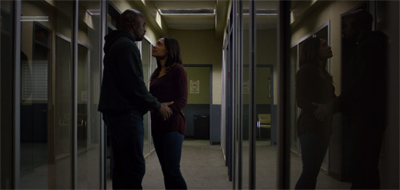
Luke even gets to restate the show’s optimistic endorsement of extra-judicial superheroes, something suggested by characters as diverse as Scarfe in Who’s Gonna Take the Weight? and Method Man in Soliloquy of Chaos. Luke explains why he has to be a superhero, and why it is important that he be a superhero, “People needed someone that didn’t require a warrant or shield to get things done. Call it a vigilante, or a superhero… call it what you will, but… like it or not, I finally accepted that that someone had to be me.”
Indeed, Luke’s speech even serves as an expression of the show’s earnest belief in the importance of role models as general concepts, of the necessity of heroic narratives over cynical detachment. It is very much a thesis statement for the show. “People are scared… but they can’t be paralyzed by that fear. You have to fight for what’s right every single day, bulletproof skin or not. You can’t just not snitch, or turn away or take money under the table because life has turned you sour. When did people stop caring?” Luke stops just short of staring into the camera.

It is a moment that is undoubtedly “corny”, but it works. It certainly works better than Karen’s abysmal closing monologue in A Cold Day in Hell’s Kitchen, for any number of reasons. Most obviously, it is much better written and doesn’t make the character delivering the monologue appear like a flaming hypocrite. More than that, Luke Cage has been so enthusiastic about its superhero trappings that the corniness becomes part of the charm. Like Stryker in his ridiculous costume, it feels like something totally fitting with the show’s world, and something it is glad to get to do.
Much like the season around it, You Know My Steez is far from perfect. It is awkwardly paced and structured, deferring pay-offs that were already delayed. At the same time, there is an undeniable charm to the episode and the show that carries it across the line. Luke Cage gets away with a lot simply because it is so enthusiastic about what it is doing and because the cast are so good that the audience doesn’t mind spending that much time with them. Luke Cage might feel a little over-extended in places, but it has enough charm to fill most of those stretches.

Luke Cage might not quite match the highs of Jessica Jones, but it is still a refreshing watch. It is a more than welcome addition to the Marvel Cinematic Universe, and a fascinating demonstration of both the strengths of and the challenges facing the Marvel Netflix series.
You might be interested in our other reviews of the first season of Luke Cage:
- Moment of Truth
- Code of the Streets
- Who’s Gonna Take the Weight?
- Step in the Arena
- Just to Get a Rep
- Suckas Need Bodyguards
- Manifest
- Blowin’ Up the Spot
- DWYCK
- Take it Personal
- Now You’re Mine
- Soliloquy of Chaos
- You Know My Steez
Filed under: Television | Tagged: luke cage, you know my steez |




















Leave a comment